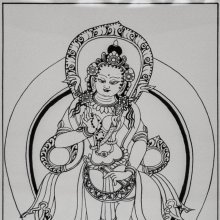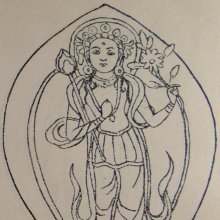Vidyapati, Vidyāpati: 6 definitions
Introduction:
Vidyapati means something in Buddhism, Pali, Hinduism, Sanskrit. If you want to know the exact meaning, history, etymology or English translation of this term then check out the descriptions on this page. Add your comment or reference to a book if you want to contribute to this summary article.
Images (photo gallery)
In Hinduism
Vaishnavism (Vaishava dharma)
Source: Shodhganga: A comparative study of the devotional vaisnavite lyrics of Assam and BengalVidyāpati (विद्यापति) was a Maithili court-poet and composed songs in Maithili. His period of life is guessed to be between 1380 A.D. and 1460 A.D. Vidyāpati’s language, though termed as Maithili, is nevertheless an admixure of Maithili and Avahaṭṭha of Apabhraṃśa. In imitation of Vidyāpati, the Vaiṣṇava poets of eastern India created a language namely Brajabuli which contains an admixure of Hindi and Maithili words saturated by their own native forms and idioms.

Vaishnava (वैष्णव, vaiṣṇava) or vaishnavism (vaiṣṇavism) represents a tradition of Hinduism worshipping Vishnu as the supreme Lord. Similar to the Shaktism and Shaivism traditions, Vaishnavism also developed as an individual movement, famous for its exposition of the dashavatara (‘ten avatars of Vishnu’).
Purana and Itihasa (epic history)
Source: archive.org: Shiva Purana - English TranslationVidyāpati (विद्यापति) or Sarvavidyāpati refers to the “lord of all lores”, and represents an epithet of Śiva, according to the Śivapurāṇa 2.2.31. Accordingly as Brahmā narrated to Nārada:—“[...] O excellent sage, in the meantime a celestial voice arose, even as Dakṣa, the Devas and others were listening. The celestial Voice said:—‘[...] Śiva alone is the creator of the universe, the lord of all lores [viz., Sarva-Vidyāpati], the upholder of the primordial learning and the lord, the most auspicious of the auspicious’”.

The Purana (पुराण, purāṇas) refers to Sanskrit literature preserving ancient India’s vast cultural history, including historical legends, religious ceremonies, various arts and sciences. The eighteen mahapuranas total over 400,000 shlokas (metrical couplets) and date to at least several centuries BCE.
In Buddhism
Tibetan Buddhism (Vajrayana or tantric Buddhism)
Source: archive.org: The Indian Buddhist IconographyVidyāpati (विद्यापति) or Vidyāpatilokeśvara refers to number 102 of the 108 forms of Avalokiteśvara found in the Machhandar Vahal (Kathmanu, Nepal). [Machhandar or Machandar is another name for for Matsyendra.].
Accordingly,—
“Vidyāpati is also similar to [Piṇḍapātra Lokeśvara], except that here the god shows the empty right hand against his chest while his left holds the lotus. The chowrie hangs from his right shoulder.—Piṇḍapātra Lokeśvara is one-faced and two-armed and stands on a lotus. He holds the Piṇḍapātra (the bowl) in his two hands near the navel.—Piṇḍapātra Lokeśvara. He is one-faced and two-armed and stands on a lotus. He holds the Piṇḍapātra (the bowl) in his two hands near the navel”.
The names of the 108 deities [viz., Vidyāpati] possbily originate from a Tantra included in the Kagyur which is named “the 108 names of Avalokiteshvara”, however it is not yet certain that this is the source for the Nepali descriptions. Tibetan Buddhism includes schools such as Nyingma, Kadampa, Kagyu and Gelug. Their primary canon of literature is divided in two broad categories: The Kangyur, which consists of Buddha’s words, and the Tengyur, which includes commentaries from various sources. Esotericism and tantra techniques (vajrayāna) are collected indepently.
Languages of India and abroad
Sanskrit dictionary
Source: Cologne Digital Sanskrit Dictionaries: Aufrecht Catalogus Catalogorum1) Vidyāpati (विद्यापति) as mentioned in Aufrecht’s Catalogus Catalogorum:—poet. Śp. p. 86. [Sūktikarṇāmṛta by Śrīdharadāsa]
2) Vidyāpati (विद्यापति):—Quoted by Abhinavagupta in Īśvarapratyabhijñāvimarśinī.
3) Vidyāpati (विद्यापति):—Cikitsāñjana med.
4) Vidyāpati (विद्यापति):—son of Gaṇapati, son of Jayadatta, son of Dhreśa, son of Devāditya, son of Karmāditya, son of Harāditya, son of Viṣṇuśarman. He lived at the end of the 14th century and in the beginning of the 15th, under Śivasiṃha, Narasiṃha, and queen Viśvāsadevī of Mithilā: Gaṅgāvākyāvalī. Dānavākyāvalī. Durgābhaktitaraṅgiṇī. Puruṣaparīkṣā. Varṣakṛtya. Vibhāgasāra. Śaivasarvasvasāra.
5) Vidyāpati (विद्यापति):—son of Vaṃśīdhara, wrote in 1682: Vaidyarahasyapaddhati.
Source: Cologne Digital Sanskrit Dictionaries: Monier-Williams Sanskrit-English Dictionary1) Vidyāpati (विद्यापति):—[=vidyā-pati] [from vidyā > vid] m. the chief scholar at a court (-tva n.), [Rājataraṅgiṇī; Vikramāṅkadeva-carita, by Bilhaṇa]
2) [v.s. ...] (also ti-svāmin) Name of various authors or scholars, [Kāvya literature etc.]
[Sanskrit to German]
Sanskrit, also spelled संस्कृतम् (saṃskṛtam), is an ancient language of India commonly seen as the grandmother of the Indo-European language family (even English!). Closely allied with Prakrit and Pali, Sanskrit is more exhaustive in both grammar and terms and has the most extensive collection of literature in the world, greatly surpassing its sister-languages Greek and Latin.
See also (Relevant definitions)
Starts with: Vidyapatilokeshvara, Vidyapatisvamin, Vidyapatitva.
Full-text (+2): Durgabhaktitarangini, Shivasimha, Vidyapatitva, Cikitsanjana, Purushapariksha, Gangavakyavali, Vaidyarahasyapaddhati, Vibhagasara, Shaivasarvasvasara, Padyamritasamudratika, Danavakyavali, Prataparudrakalyana, Vishvasadevi, Varshakritya, Vaidyarahasya, Nrisimha deva, Vamshidhara, Vidyapatilokeshvara, Adividya, Lakshmipati.
Relevant text
Search found 15 books and stories containing Vidyapati, Vidyāpati, Vidya-pati, Vidyā-pati; (plurals include: Vidyapatis, Vidyāpatis, patis). You can also click to the full overview containing English textual excerpts. Below are direct links for the most relevant articles:
The Indian Buddhist Iconography (by Benoytosh Bhattachacharyya)
Love Songs of Vidyapati < [July – September 1974]
Lotus of Delight < [December 1944]
A Song of Vidyapati < [September 1938]
The Skanda Purana (by G. V. Tagare)
Chapter 9 - Vidyāpati Reports to Indradyumna < [Section 2 - Puruṣottama-kṣetra-māhātmya]
Chapter 8 - The Messenger Vidyāpati Returns < [Section 2 - Puruṣottama-kṣetra-māhātmya]
Chapter 14 - Nārada Consoles Indradyumna < [Section 2 - Puruṣottama-kṣetra-māhātmya]
A History of Indian Philosophy Volume 3 (by Surendranath Dasgupta)
Part 1 - Date of Bhāskara < [Chapter XV - The Bhāskara School of Philosophy]
Varahi Tantra (English Study) (by Roberta Pamio)
Chapter 28 - Durgāpūjā (the worship of Durgā) < [Summary of the Vārāhī Tantra]
Brief outline of the Vārāhī Tantra
Bhajana-Rahasya (by Srila Bhaktivinoda Thakura Mahasaya)
Text 23 < [Chapter 8 - Aṣṭama-yāma-sādhana (Rātri-līlā–prema-bhajana sambhoga)]
Related products


